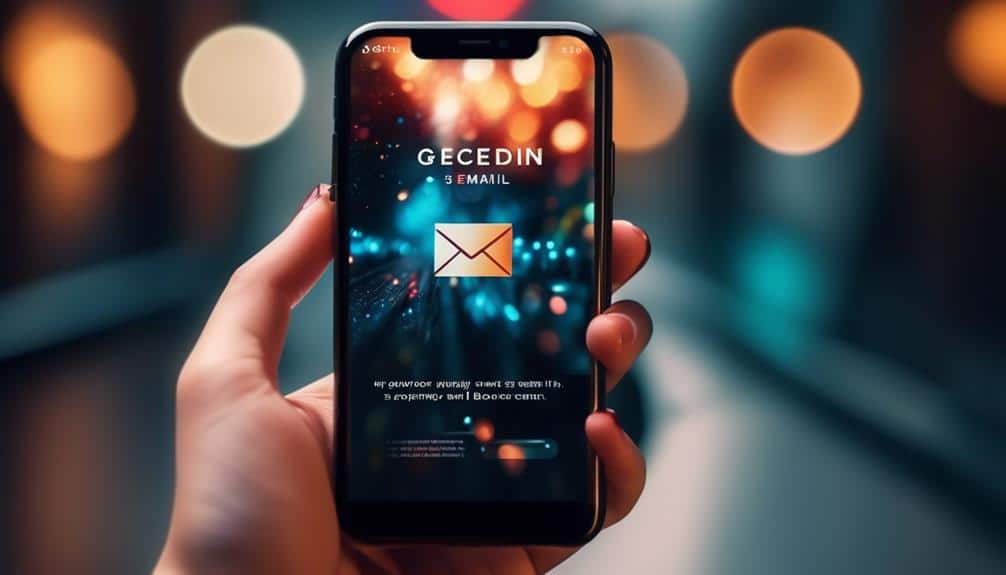Act Now: Uncover the Power of Persuasive Email Content Before It's Too Late
Are you tired of sending emails that go unnoticed and unread? Perhaps you've been struggling to capture the attention and interest of your target audience. Well, fret no more!
In the world of digital communication, the power of persuasive email content cannot be underestimated. But here's the catch – this power remains untapped by many. You see, crafting an effective email goes beyond simply stringing words together. It requires a deep understanding of your audience, a knack for grabbing attention, and the ability to build trust and credibility.
So, if you're ready to unlock the secrets of persuasive email content, keep reading. The time to act is now, before it's too late.
Key Takeaways
- Persuasive email content is essential for maximizing conversions and should focus on addressing the audience's pain points and offering solutions.
- Understanding the target audience is crucial for impactful emails, and personalizing the messaging to speak directly to their desires and needs.
- Audience segmentation based on demographics, psychographics, and buying behavior can provide valuable insights for tailoring persuasive messaging.
- Attention-grabbing subject lines that are concise, personalized, and create curiosity can significantly increase email open rates.
The Importance of Persuasive Email Content

Why is persuasive email content crucial for achieving your goals?
The answer lies in the power of effective persuasion techniques and the impact they can have on maximizing email conversions. When crafting your email content, it's important to understand that your audience desires a service-oriented approach. They want to be served, understood, and convinced that your offering is the best solution for their needs.
To achieve this, you need to employ effective persuasion techniques that resonate with your audience. Use language that speaks directly to their pain points and offers compelling solutions. Create a sense of urgency by highlighting the benefits they stand to gain from taking action now.
Understanding Your Target Audience
You want your emails to have maximum impact, right?
Well, understanding your target audience is the key to achieving that. By utilizing audience analysis techniques, you can uncover valuable insights about your customers, such as their preferences, needs, and pain points.
Armed with this knowledge, you can tailor your email content effectively, speaking directly to their desires and providing solutions that resonate with them.
Audience Analysis Techniques
Understanding your target audience is crucial for creating persuasive email content. By conducting audience analysis techniques such as audience segmentation, you can gain valuable insights into the needs, preferences, and motivations of your audience. This allows you to tailor your persuasive messaging to resonate with them on a deeper level.
To help you better understand your target audience, here is a handy table that outlines three key aspects to consider:
| Aspect | Questions to Ask | Benefits |
|---|---|---|
| Demographics | What is their age, gender, etc.? | Helps you personalize your email content |
| Psychographics | What are their interests? | Enables you to align your messaging |
| Buying Behavior | How do they make purchasing decisions? | Lets you craft compelling calls to action |
Customer Profiling Strategies
To better connect with your target audience, employ effective customer profiling strategies that delve into their motivations and desires. Customer segmentation is a crucial step in understanding your audience on a deeper level. By categorizing customers based on demographics, interests, and behaviors, you can create personalized messaging that resonates with their specific needs.
Understanding your customers' desires allows you to tailor your content and offers to their preferences, increasing the likelihood of engagement and conversion. Personalized messaging shows that you value your customers as individuals and are committed to meeting their unique needs. It helps build trust and establishes a strong connection between your brand and your audience.
Tailoring Content Effectively
Crafting content that speaks directly to the motivations and desires of your target audience is essential for effective communication. To tailor your content effectively, consider these tailoring techniques and personalization strategies:
- Understand your audience: Take the time to research and analyze your target audience. Understand their preferences, needs, and pain points.
- Segment your audience: Break your audience into smaller groups based on demographics, interests, or behaviors. This allows for more personalized messaging.
- Use data-driven insights: Leverage data to gain insights into your audience's preferences and behaviors. This will help you create content that resonates with them.
Crafting Attention-Grabbing Subject Lines
Are you tired of sending emails that go unnoticed and unopened?
The key to capturing your audience's attention lies in crafting attention-grabbing subject lines.
By using captivating email subject lines, you can entice your recipients to click and open your emails, increasing the chances of them engaging with your message.
Don't let your emails get lost in the clutter – make your subject lines stand out and grab their attention from the start.
Captivating Email Subject Lines
Unlock the Power of Persuasion with Attention-Grabbing Email Subject Lines.
Crafting captivating email subject lines is crucial for grabbing your reader's attention and increasing the chances of them opening your email. To ensure your subject lines are effective, follow these tips:
- Keep it concise: Use short and impactful subject lines that convey the main message of your email.
- Use personalization: Tailor your subject lines to resonate with your audience by incorporating their name or other relevant information.
- Create curiosity: Spark intrigue by using compelling and mysterious subject lines that make your readers curious to know more.
Engaging Message Openers
To truly captivate your readers, start your email off with an attention-grabbing message opener that immediately hooks them in. Engaging storytelling and personalized greetings can make all the difference in capturing their interest and encouraging them to continue reading.
Craft a subject line that piques curiosity and entices them to open your email. Once they're in, use a compelling opening line that sparks their curiosity or emotions.
Consider using a table to present important information in a visually appealing way. This adds a level of sophistication to your email and draws attention to key points.
Writing Compelling Email Introductions

Crafting an attention-grabbing email introduction is essential for capturing your recipient's interest and compelling them to read further. In a world where inboxes are flooded with emails vying for attention, your email introduction needs to stand out.
Here's how you can write compelling email introductions that make your audience want to keep reading:
- Personalization: Address your recipient by name and mention something specific to them, like a recent achievement or shared interest. This shows that you've taken the time to understand them and creates a sense of connection.
- Intriguing statement: Begin with a thought-provoking question or a surprising statement that sparks curiosity. This engages the reader and entices them to continue reading to find out more.
- Value proposition: Clearly communicate the benefit or value your email offers. Let your recipient know what they stand to gain by reading further. Whether it's a solution to a problem or valuable information, make it clear why they should invest their time in your email.
Building Trust and Credibility in Your Emails
Now that you've captured your recipient's attention with a compelling email introduction, it's time to establish trust and credibility in your emails.
Building rapport and establishing credibility are essential in gaining the trust of your audience and convincing them to take action.
To build rapport, it's important to personalize your emails. Address your recipients by their name and show that you understand their needs and concerns. Use language that resonates with them and make them feel valued.
Additionally, share relevant and valuable information that demonstrates your expertise in the subject matter. This will establish your credibility and position you as a trusted source of information.
Another way to build trust is to provide social proof. Include testimonials or success stories from satisfied customers who've benefited from your products or services. This will show that others have had positive experiences with you and increase your credibility.
Lastly, be transparent and honest in your emails. Avoid making exaggerated claims or false promises. Instead, provide accurate information and set realistic expectations. This will build trust and credibility with your audience, making them more likely to engage with your emails and take the desired action.
Using Persuasive Language and Emotional Appeals

Ready to take your email game to the next level?
Mastering the art of persuasive language and emotional appeals is the key to capturing your reader's attention and driving them to take action.
By strategically incorporating emotional triggers, crafting compelling subject lines, and using power words that evoke a response, you can create emails that not only stand out in the inbox but also compel your audience to act.
Get ready to harness the power of words and start crafting emails that truly persuade.
Emotional Triggers in Emails
Harness the power of emotion in your emails by using persuasive language and tapping into emotional triggers. By leveraging emotions in email marketing, you can create a stronger connection with your audience and increase the effectiveness of your communication.
Here are three emotional triggers to consider incorporating into your emails:
- Sense of urgency: Create a fear of missing out or a time-sensitive opportunity to motivate your readers to take immediate action.
- Empathy: Show understanding and compassion towards your audience's needs and challenges to build trust and establish a genuine connection.
- Excitement: Use enthusiastic and positive language to evoke feelings of anticipation and enthusiasm, making your readers more receptive to your message.
Crafting Persuasive Subject Lines
Craft captivating subject lines that utilize persuasive language and tap into emotional appeals to instantly grab your reader's attention.
When crafting subject lines, it's crucial to create curiosity and leverage personalization to make your emails stand out in a crowded inbox.
By using persuasive language, you can pique your reader's interest and entice them to open your email. Words like 'exclusive,' 'limited time offer,' or 'urgent' can create a sense of urgency and make your email more compelling.
Additionally, incorporating emotional appeals into your subject lines can evoke feelings of excitement, fear, or curiosity, making your reader more likely to click.
Personalizing subject lines with the recipient's name or referencing their previous interactions with your brand can also increase open rates.
Power Words for Persuasion
Using persuasive language and emotional appeals in your email content can greatly enhance your ability to captivate and persuade your audience. By incorporating power words, you can evoke strong emotions and create a sense of urgency. Consider using words like 'exclusive,' 'limited time,' and 'urgent' to trigger a fear of missing out.
Additionally, words like 'guaranteed,' 'proven,' and 'results' can instill confidence and credibility in your message. Psychological tactics such as appealing to the reader's desire for recognition, security, or personal growth can also be effective. Use words like 'succeed,' 'transform,' and 'empower' to tap into their aspirations and motivations.
Incorporating Social Proof and Testimonials

When it comes to convincing your audience, there's nothing quite as powerful as incorporating social proof and testimonials. Social validation techniques and testimonial effectiveness are essential tools in building trust and credibility with your audience. People are more likely to believe and take action when they see that others have had positive experiences with your product or service.
Social proof can take many forms. It can be in the form of customer reviews, ratings, or testimonials on your website or social media platforms. Sharing statistics or data that demonstrate the popularity or success of your product can also be effective. By showcasing the experiences and opinions of satisfied customers, you provide social validation for your claims.
Testimonials, in particular, have a unique power to persuade. When potential customers see real-life stories of how your product or service has positively impacted someone else's life, they're more likely to envision themselves experiencing the same benefits. Testimonials create an emotional connection and evoke trust, making it easier for your audience to make a decision.
To maximize the impact of social proof and testimonials, make sure they're authentic and relatable. Use real customer stories and experiences, and include specific details that highlight the transformation or improvement they experienced. Remember, the more genuine and relatable the testimonial, the more effective it will be in persuading your audience.
Incorporating social proof and testimonials into your email content can significantly increase your conversion rates. Don't miss out on this powerful persuasion technique. Start leveraging the power of social proof and testimonials today and watch your audience respond positively to your message.
Creating a Sense of Urgency and FOMO
To create a sense of urgency and capitalize on the fear of missing out (FOMO), it's crucial to convey a message that compels your audience to take immediate action. By creating scarcity, you can make your audience feel like they must act now in order to secure a limited opportunity. Here's how you can do it:
- Limited Time Offer: Highlight that the offer is only available for a limited time. Emphasize that your audience must act quickly to take advantage of the opportunity before it expires.
- Limited Quantity: Mention that there are only a limited number of spots, products, or tickets available. This creates a sense of exclusivity and makes your audience feel like they need to act fast to secure their spot.
- Exclusive Access: Offer exclusive access or early bird discounts to create a sense of privilege. Let your audience know that this opportunity is only available to a select few, and they don't want to miss out on being part of an exclusive group.
Designing Engaging and Mobile-Friendly Emails

Crafting captivating and user-friendly emails that grab attention and drive action is essential in today's mobile-centric world. With the rise of smartphones and tablets, more and more people are accessing their emails on the go. This means that your emails need to be designed with mobile in mind to ensure maximum engagement.
Mobile design is all about creating emails that are visually appealing and easy to navigate on smaller screens. This means using a responsive layout that adapts to different screen sizes and optimizing images and buttons for touchscreens. By incorporating mobile design principles, you can create emails that not only look great on mobile devices but also provide a seamless user experience.
Email engagement is crucial for the success of your email marketing campaigns. To increase engagement, you need to make sure that your emails aren't only visually appealing but also contain valuable content. Personalization and segmentation can help you deliver targeted messages that resonate with your audience. Including interactive elements like polls or quizzes can also encourage recipients to interact with your emails and increase engagement.
Optimizing Call-to-Action Buttons for Higher Conversions
Boost your email conversions with optimized call-to-action buttons that drive action. The design and placement of your call-to-action buttons play a crucial role in determining whether your subscribers will take the desired action or not.
To optimize your call-to-action buttons for higher conversions, keep the following tips in mind:
- Button design: Make your call-to-action buttons visually appealing and easily noticeable. Use contrasting colors that stand out from the rest of your email content. Consider using bold fonts and incorporating compelling graphics or icons to make your buttons more enticing.
- Conversion optimization: Experiment with different button placements to find the most effective position. Generally, placing your call-to-action buttons above the fold increases their visibility and encourages more clicks. Additionally, ensure that your buttons are large enough to be easily clickable on mobile devices.
- Clear and concise messaging: Use persuasive and action-oriented language on your buttons. Instead of generic phrases like 'Click here,' use more specific and compelling statements that clearly communicate the value of taking action. For example, 'Get your free ebook now!' or 'Start your 30-day trial today!'
Frequently Asked Questions
How Can I Measure the Effectiveness of Persuasive Email Content?
Want to measure the effectiveness of your persuasive email content? Try A/B testing to see which version gets higher open rates. Don't wait, act now and uncover the power of your emails!
What Are Some Common Mistakes to Avoid When Crafting Subject Lines?
Avoiding spam triggers is crucial when crafting subject lines. Keep them concise and engaging to capture attention. Don't make the mistake of using excessive punctuation or misleading language. Your subject lines should intrigue and serve your audience.
Are There Any Specific Strategies for Building Trust and Credibility in Email Content?
To build trust and credibility in your email content, focus on building rapport and establishing authority. Connect with your audience by understanding their needs, provide valuable information, and demonstrate your expertise. You'll create a lasting impression and strengthen your relationship.
How Can I Incorporate Social Proof and Testimonials Effectively in My Emails?
To effectively incorporate social proof and testimonials in your emails, use real-life success stories and customer feedback to build credibility. Show how others have benefited from your product or service, creating trust and persuading your audience to take action.
What Are Some Best Practices for Optimizing Call-To-Action Buttons for Higher Conversions?
Optimizing call-to-action buttons is crucial for higher conversions. Consider button design and placement to make it stand out and encourage action. Don't miss out on the power of persuasive email content. Act now!
Conclusion
Act now and unlock the potential of persuasive email content to drive conversions and capture your audience's attention.
By understanding your target audience, crafting attention-grabbing subject lines, and writing compelling introductions, you can build trust and credibility in your emails.
Incorporating social proof and testimonials, creating a sense of urgency, and designing engaging mobile-friendly emails will further enhance your results.
Don't miss out on this opportunity to optimize your call-to-action buttons for higher conversions.
Start implementing these strategies today and watch your email marketing campaigns soar.








